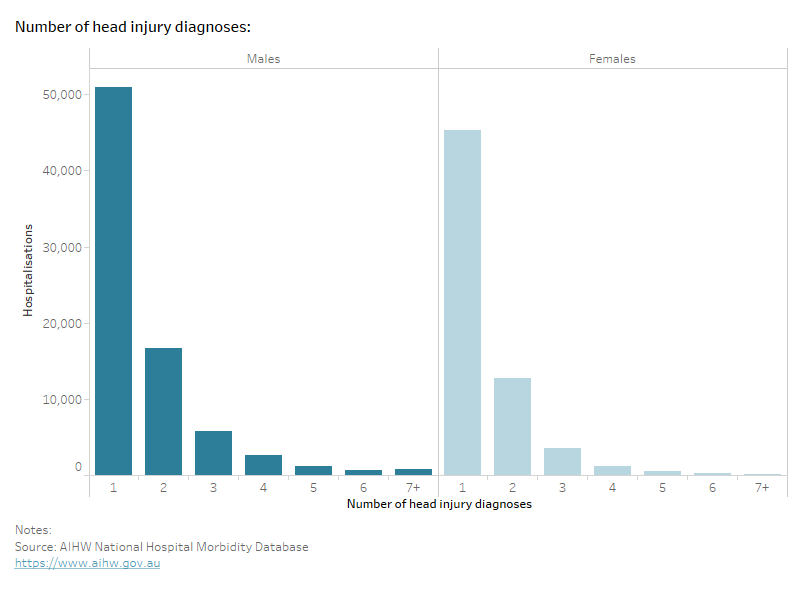Types of head injury
This report discusses common injury types including:
- Fracture: A partial or complete break in a bone
- Soft-tissue injury: Sprain or strain of muscles, ligaments or joints
- Open wound: A break in the skin such as a cut, puncture or bite
- Intracranial injury: inside the skull (often a concussion)
- Dislocation: A separation of different bones where they join
- Superficial injury: An injury to the skin surface such as abrasion, bruising or blistering.
The most common type of head injury for ED presentations and hospitalisations was an open wound (28% and 27% respectively). This was followed by:
- superficial injuries, and foreign object (through orifice) for ED presentations (14% and 11%)
- intracranial injuries, and fractures for hospitalisations (22% and 16%) (Table 6).
In contrast, the top three types of injuries for all injury hospitalisations and ED presentations were:
- Fractures
- Open wounds
- Soft-tissue injuries (sprains or strains of muscles, ligaments or joints).
| Head injury ED presentations | % | All injury ED presentations | % | Head injury hospitalisations | % | All injury hospitalisations | % |
|---|---|---|---|---|---|---|---|
| Open wound | 28 | Fracture | 22 | Open wound | 27 | Fracture | 38 |
| Superficial injury | 14 | Open wound | 17 | Intracranial injury | 22 | Open wound | 16 |
| Foreign object (through orifice) | 11 | Soft-tissue | 15 | Fracture | 16 | Soft-tissue | 10 |
Source: AIHW National Hospitals Morbidity Database and AIHW National Non-admitted Patient Emergency Department Care (NNAPEDC) Database
An injury to the eye membrane without a foreign body was the most common ED head injury diagnosis with a specified bodily location (19,900). For hospitalisations, it was an open wound of the scalp (14,000).
Types of injuries and presentation patterns changed depending on age and sex.
Those aged 0–4 had the highest rate of ED presentations for head injuries (5,600 per 100,000), and Figure 9 shows that they had the highest rates for:
- open wounds (2,200 per 100,000)
- other unspecified and not reported injuries (1,900 per 100,000)
- superficial injuries (930 per 100,000)
- intracranial injuries (230 per 100,000)
- burns (46 per 100,000)
- crushing injuries (14 per 100,000)
The rate of fractures, dislocations, and soft-tissue injures were all highest among 15–24-year-olds.
Figure 9: Number and rate of ED presentations and hospitalisations for head injuries, by injury type and age group, 2020–21
A stacked bar chart showing that the 0–4 age group had the highest rates of ED presentations for head injuries across open wound, superficial, intracranial, and burns. Among hospitalisations, the top types of head injuries were open wound for those aged 0–14, and 65 and over. Fracture was the top type for those aged 15–44 and intracranial injury for those aged 45–64.

The 65 and over age group were particularly prone to head injury hospitalisations involving open wounds (310 per 100,000), and had the highest rates across most other head injury types.
Notable exceptions were:
- the 15–24 age group had the highest rates of fractures (112 per 100,000)
- the 0–4 age group had the highest rates of foreign object (through orifice) injuries (25 per 100,000 population)
- the 0–4 age group had the highest rates of dislocation injuries (18 per 100,000 population).
- the 0–4 age group had the highest rate of burns (13 per 100,000 population)
Figure 10 shows that a foreign body in the ear is the only ED head injury diagnosis where females have higher numbers of presentations (6,900 and 6,600 comparatively)
For hospitalisations, females have higher numbers for:
- a bruise to other parts of the head (6,800 and 4,700 comparatively)
- a bruise to the scalp (6,000 and 4,500 comparatively).
Figure 10: Top 10 head injury diagnoses by sex, 2020–21
Butterfly chart showing that open wound of other parts of head was the most common diagnosis, and that overall, there were more cases in males than females. This trend was reversed for bruise of scalp, and superficial injury of head, contusion, where females had more cases than males.

Concussion
Concussions are typically associated with contact sports, however they can occur in nearly every sport (AIHW 2023e). Sports injuries contributed to 3,100 hospitalisations (24%) for concussive injuries.
People under 25 made up 63% of concussion hospitalisations.
Concussion:
- was the most common head injury for those aged 5–14 and hospitalised with a head injury (1,500 cases), and the third most common for 15–24-year-olds (1,500 cases)
- was the third most frequent type of head injury for females presenting to ED (7,800)
- in males presenting to the ED had 1.5 times the number of diagnoses (11,700 cases) than females
- was among the top ten head injury diagnoses during hospitalisation for people aged under 45.
Multiple head injury diagnoses were more frequently recorded in:
- males (35%) compared to females (29%)
- People aged 25–44 (40%) compared with other age groups
The 65 and over age group had a higher proportion of hospitalisations with multiple head injuries compared to the 0–4 age group (30% and 22% respectively).
Males and females see similar drop-off rates in the number of head injury diagnoses (Figure 11).
Falls caused over half of hospitalisations with multiple head injuries
Out of all causes of head injury hospitalisations:
- falls had the largest number of hospitalisations with multiple head injury diagnosis (24,700)
- transport and assault had the highest average number of head injury diagnoses per hospitalisation (1.9)
- nearly half of assaults (49%) resulting in head injury hospitalisations had multiple head injury diagnoses recorded.
Figure 11: Number of head injury diagnosis by sex, 2020–21
Stacked bar chart showing that for both males and females, the most common number of head injury diagnoses was one.

AIHW (2023e) Sport injury in Australia, AIHW, Australian Government, accessed 14 June 2023.


